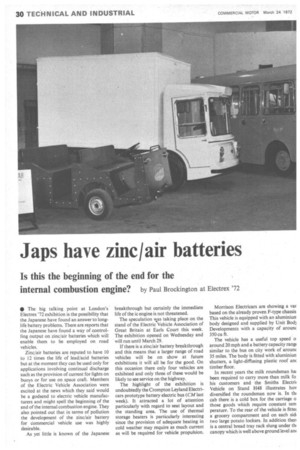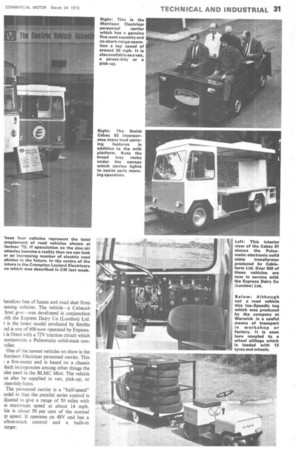Japs have zinc/air batteries
Page 32

Page 33

If you've noticed an error in this article please click here to report it so we can fix it.
Is this the beginning of the end for the
internal combustion engine? by Paul Brockington at Electrex '72
• The big talking point at London's Electrex '72 exhibition is the possibility that the Japanese have found an answer to longlife battery problems. There are reports that the Japanese have found a way of controlling output on zinc/air batteries which will enable them to be employed on road vehicles.
Zinc/air batteries are reputed to have 10 to 12 times the life of lead/acid batteries but at the moment they can be used only for applications involving continual discharge such as the provision of current for lights on buoys or for use on space craft. Members of the Electric Vehicle Association were excited at the news which they said would be a godsend to electric vehicle manufacturers and might spell the beginning of the end of the internal combustion engine. They also pointed out that in terms of pollution the development of the zinc/air battery for Commercial vehicle use was highly desirable.
As yet little is known of the Japanese breakthrough but certainly the immediate life of the ic engine is not threatened.
The speculation vas taking place on the stand of the Electric Vehicle Association of Great Britain at Earls Court this week. The exhibition opened on Wednesday and will run until March 29.
If there is a zinc/air battery breakthrough and this means that a larger range of road vehicles will be on show at future exhibitions it will all be for the good. On this occasion there only four vehicles are exhibited and only three of these would be likely to see service on the highway.
The highlight of the exhibition is undoubtedly the Crompton Leyland Electricars prototype battery electric bus (CM last week). It attracted a lot of attention particularly with regard to seat layout and the standing area. The use of thermal storage heaters is particularly interesting since the provision of adequate heating in cold weather may require as much current as will be required for vehicle propulsion. Morrison Electricars are showing a var based on the already proven F-type chassis This vehicle is equipped with an aluminiunr body designed and supplied by Unit B0d3 Developments with a capacity of arount 350 cu ft.
The vehicle has a useful top speed o around 20 mph and a battery capacity rang( similar to the bus on city work of arounc 35 miles. The body is fitted with altuniniun shutters, a light-diffusing plastic roof an timber floor.
In recent years the milk roundsman ha been required to carry more than milk fo. his customers and the Smiths Electrii Vehicle on Stand H48 illustrates hov diversified the roundsman now is. In thi cab there is a cold box for the carriage o those goods which require constant tern perature. To the rear of the vehicle is fitter a grocery compartment and on each sid, two large potato lockers. In addition then is a central bread tray rack slung under thi canopy which is well above ground level an
herefore free of fumes and road dust from lassing vehicles. The vehicle—a Cabacab 5cwt gvw—was developed in conjunction iith the Express Dairy Co (London) Ltd. t is the latest model produced by Smiths rid is one of 400 now operated by Express. t is fitted with a 72V traction circuit which lcorporates a Pulsomatic solid-state con-oiler.
One of the newest vehicles on show is the 4orrison Electricar personnel carrier. This ; a five-seater and is based on a chassis thich incorporates among other things the ?des used in the BLMC Mini. The vehicle an also be supplied in van, pick-up, or .reet-tidy form.
The personnel carrier is a "half-speed" yodel in that the parallel series control is ijusted to give a range of 50 miles with le maximum speed at about 14 mph, his is about 50 per cent of the normal )p speed. It operates on 48V and has a trbon-stack control and a built-in larger.




















































































































































